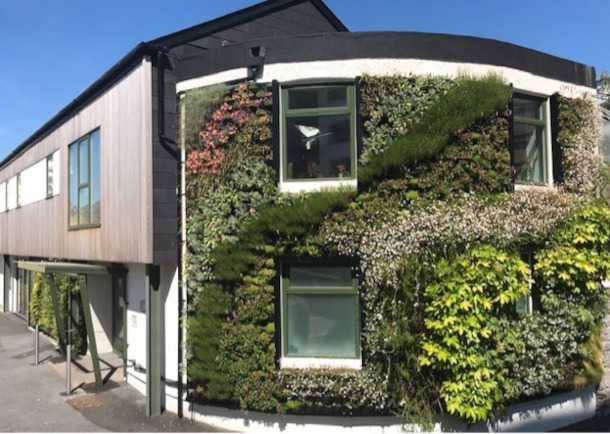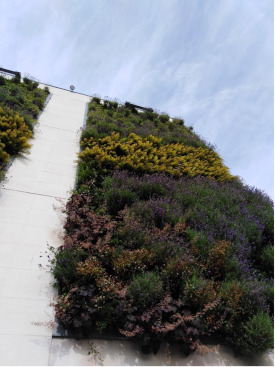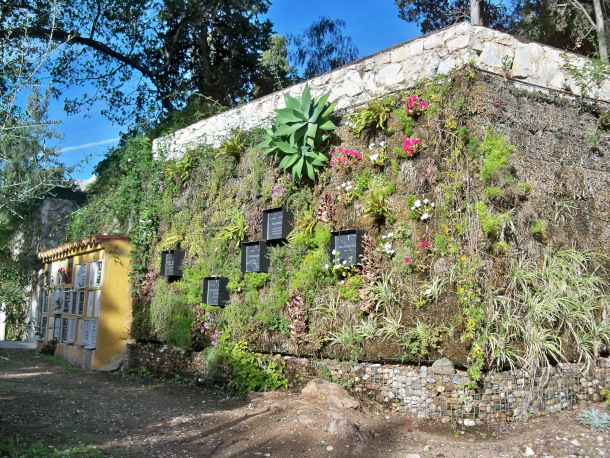Green Walls For Life, Air and Energy
Air Date: Week of February 11, 2022

The Living Walls from University of Plymouth (Photo: Paul Lunt, University of Plymouth)
Green walls, which are living walls of plants installed on the side of buildings, can help clean the air, improve energy efficiency, and support biodiversity. Matthew Fox, a researcher at the University of Plymouth, joins Host Bobby Bascomb to talk about how green walls work, their potential applications, and the benefits they offer for people and pollinators.
Transcript
BASCOMB: Researchers at the University of Plymouth in the UK have been looking into the many benefits of installing a living wall of plants on the side of buildings. They’ve found the green walls can work like insulation to dramatically reduce heat loss and improve energy efficiency. And the plants, including evergreen grasses and native flowers like daisies, can filter fine particulates smaller than pm 2.5 to improve local air quality. Matthew Fox is a researcher at the University of Plymouth who studies green walls on buildings and joins me now for more. Welcome to Living on Earth!
FOX: Thank you very much, Bobby. Lovely to talk to you.
BASCOMB: So what was your basic finding in this study in terms of the benefits of green walls when it comes to you know, heat and energy savings?
FOX: Okay, so at Plymouth, we were measuring the heat flow through two pieces of construction that were identical. Apart from one section of the wall, we had an external Greenwald facade. And we use scientific equipment on both of those sections of walling to measure that flow of heat through the walling. And really interestingly, we found that by placing an external facade of green walling, we improved the heat for the thermal performance by approximately 1/3 over the original state of that wall.
BASCOMB: And so are the plants acting as sort of like an insulation then? Is that how it works?
FOX: Yes, so we believe that the planting is acting as a slight insulator. And interestingly, we're thinking that the foliage is acting as a wind buffer against the external surface of the wall. So it's not just necessarily the the material of the green walling itself or the soil, but actually the sort of physical makeup of the external facade, and the way in which it might trap air pockets, in the same way that you'll have trapped air pockets within a polystyrene insulation, or mineral wool insulation, you're actually getting this in the planting itself.
BASCOMB: And of course, you'd have the opportunity here to plant native species and perhaps help local pollinators. Can you tell us a bit about the potential there?
FOX: Yeah, definitely. So for our green wall, we specifically looked for local native plants, rather than bringing in foreign species. And the benefit of that is that you then attract the local biodiversity, so the local insects and as you said pollinators to the plants, and some of the plants we chose, we chose specifically because of a flowering plants. So during the spring and summer months, you provide those sort of perfect opportunities for the pollinating insects and bees to kind of come in, and you're providing that kind of platform for those insects to thrive, which in the UK, I don't know how it is in the States, but our population of bees and other insects pollinating insects are dwindling. So if green walls could be encouraged, then, who knows? We could help to reverse the decline in pollinating insects.

University of Plymouth’s first green wall (Photo: Paul Lunt, University of Plymouth)
BASCOMB: It's a problem worldwide, unfortunately. So how exactly do green walls work? I mean, how do you keep the soil and the plants in place on a vertical surface?
FOX: Okay, so we're using something called a phyto textile, which is recycled plastics, that are kind of broken down into almost like a fiber. And they're kind of they're woven together into these small pockets, which you then fill up with the soil matter. And then you can plant your plants into those pockets. And they're all hung on a vertical metal system that's fixed back to the existing walls, facade. And they're all kept nice and watered by an irrigation system, the irrigation system that we've got done at Plymouth is fed by a grey water harvesting tank. So it's taking rainwater from the sky, storing it in the tank, and then we have this gravity fed irrigation system through the plants. So it's all sort of low impact watering system there.
BASCOMB: So I'm imagining, it's sort of like one of those things you put over the door to put your shoes in you know, and each little pocket withholds soil and a plant. Is that the idea?
FOX: That's exactly what it would look like, except instead of your slippers, it would be soil.
BASCOMB: What advantage, if any, is there have a green wall over a green roof, let's say, which is maybe a bit more common?
FOX: The benefit of a green wall over a green roof is that you can more easily hang the green wall off an existing building. So with a green roof, typically you need more construction work to be able to facilitate that. So when you put a green roof in, the foundations might need to be enhanced to take the loading. So the green roofs are heavier weight than a green wall facade. Also, you might need to improve the roof structure to be able to take the green roof, whereas with the green wall is just a very simple frame that will work on the outside of the building. And I think it's a much lower cost solution for retrofitting.
BASCOMB: Now, is this something that a homeowner could do on their own home? Or do you need to have you know, professionals come and install this green wall?
FOX: A homeowner could absolutely do this themselves. And we're working with researchers in Holland and Germany at the moment and looking at a system that they're creating using 3d printing to create some really innovative wall planting systems. So a slightly different greenwall facade to what we've used down at Plymouth. And this is the sort of thing that you can buy off the shelf, or will you hopefully be able to buy off the shelf in the future. And it is very straightforward to install.

Vertical garden and columbarium at the English Cemetery in Málaga, Spain. (Photo: Daniel Capilla, Wikipedia Commons)
BASCOMB: So you did this research in the UK, which gets pretty chilly. But where I'm sitting here in New England, the height today is going to be about 20 degrees or negative 6 Celsius. How appropriate is this idea of a greenwall for very cold climates?
FOX: Okay, well, you'd be surprised at how cold it gets in the UK. However, in the UK, our main concern is rain and precipitation. We are a maritime climate. And we get battered by the Atlantic weather fronts that come in. And we're primarily concerned about water and protecting from water. In a really cold climate, I think that what we've demonstrated through our research is that a green wall could help to give an extra layer of thermal buffering, so we can help to minimize the heat loss through buildings. We're going to be looking at how a green facade can benefit buildings during the summer, because you just pointed out a 20 degree high could be experienced during the winter, I've no doubt during the summer months, you have higher temperatures that we enjoy in the UK. And there's certainly research out there that suggests a green wall facade during the summer can help to cool the internal space, it can reduce the cooling demand, so reduce the need to have artificial air conditioning during the summer months. So the green wall facade could give you benefits both in the winter and in the summer. And that's certainly something we're gonna be looking at going forwards as part of our research project.
BASCOMB: What do you see as the potential social benefits of green walls? And you know, how have people responded to them so far.
FOX: We're particularly taken by the interest in green walls. The response we've had from people who live in and around these areas has been fantastic. And in the building that we were doing the research on, they have an internal green wall as well. And it's the area of the building where new people who are visitors who come to this building, they kind of gravitate towards it. It's like a magnet, it draws you towards the wall, and you want to go and touch the wall, you want to sniff the plants, and everyone comments on it. And it's always positive. People really engage with the green wall, whether it's inside or outside. And that's not you don't find that with any other building material. And perhaps we need to be looking at buildings of the future that engage people on that basis.
BASCOMB: Matthew Fox is a researcher and associate lecturer at the University of Plymouth School of Art Design and Architecture. Matthew, thank you so much for taking the time with me today.
FOX: It's an absolute pleasure, Bobby, thank you very much for having me along.
Links
University of Plymouth | “Living Walls Can Reduce Heat Lost from Buildings by Over 30%, Study Shows”
Living on Earth wants to hear from you!
Living on Earth
62 Calef Highway, Suite 212
Lee, NH 03861
Telephone: 617-287-4121
E-mail: comments@loe.org
Newsletter [Click here]
Donate to Living on Earth!
Living on Earth is an independent media program and relies entirely on contributions from listeners and institutions supporting public service. Please donate now to preserve an independent environmental voice.
NewsletterLiving on Earth offers a weekly delivery of the show's rundown to your mailbox. Sign up for our newsletter today!
 Sailors For The Sea: Be the change you want to sea.
Sailors For The Sea: Be the change you want to sea.
 Creating positive outcomes for future generations.
Creating positive outcomes for future generations.
 Innovating to make the world a better, more sustainable place to live. Listen to the race to 9 billion
Innovating to make the world a better, more sustainable place to live. Listen to the race to 9 billion
 The Grantham Foundation for the Protection of the Environment: Committed to protecting and improving the health of the global environment.
The Grantham Foundation for the Protection of the Environment: Committed to protecting and improving the health of the global environment.
 Contribute to Living on Earth and receive, as our gift to you, an archival print of one of Mark Seth Lender's extraordinary wildlife photographs. Follow the link to see Mark's current collection of photographs.
Contribute to Living on Earth and receive, as our gift to you, an archival print of one of Mark Seth Lender's extraordinary wildlife photographs. Follow the link to see Mark's current collection of photographs.
 Buy a signed copy of Mark Seth Lender's book Smeagull the Seagull & support Living on Earth
Buy a signed copy of Mark Seth Lender's book Smeagull the Seagull & support Living on Earth

